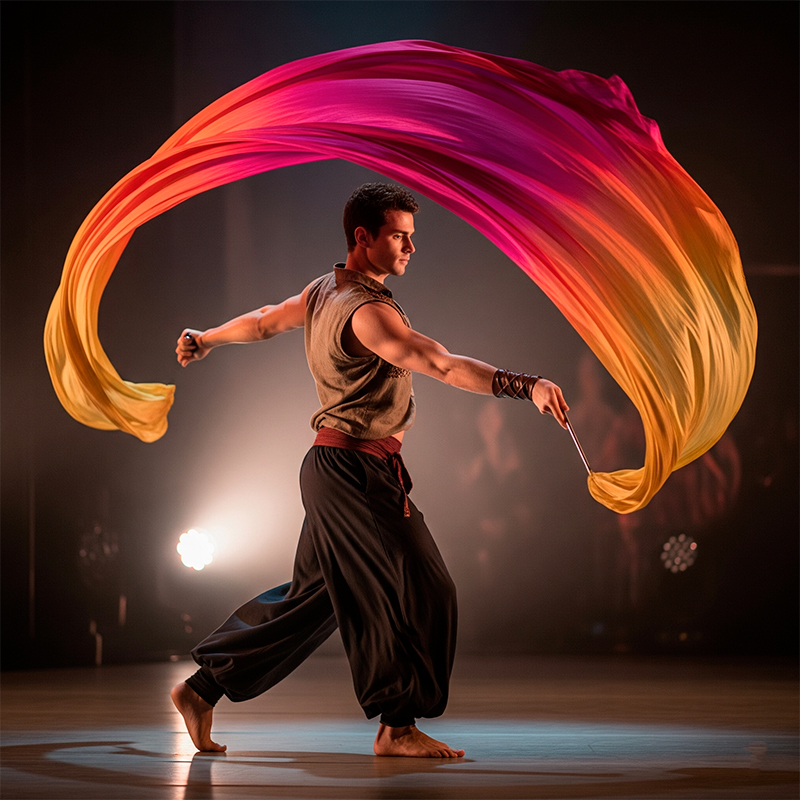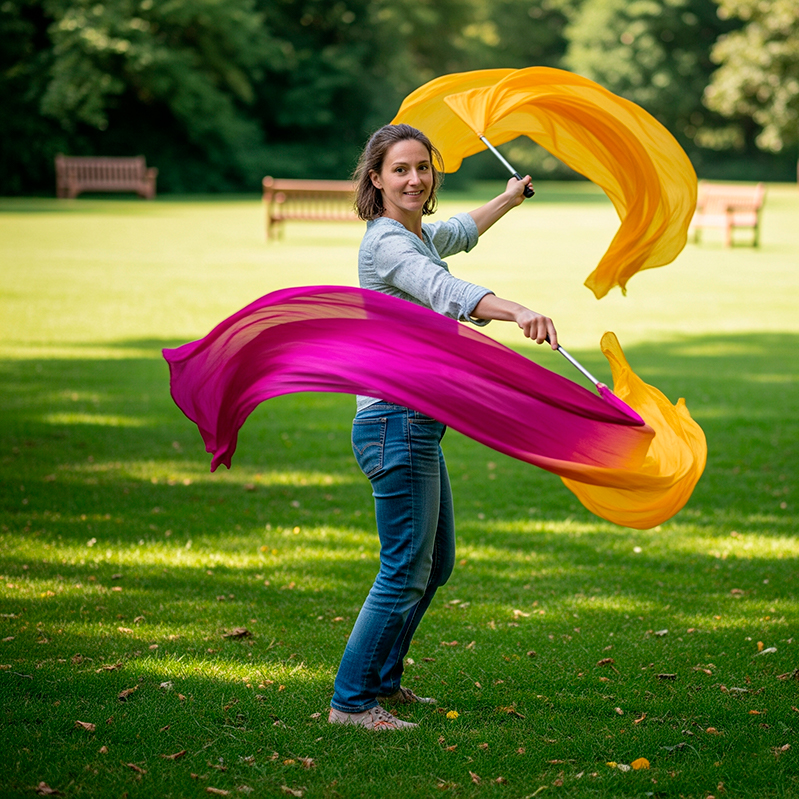Learning veil poi spinning is one of the most beautiful and accessible ways to enter the world of flow arts. Whether you’re drawn to the hypnotic patterns of silk poi in motion or the captivating grace of combining poi with dance, there’s something uniquely magical about this art form. In this guide, I’ll walk you through the easiest veil poi moves to get started, share what makes fabric poi ideal for beginners, and show how to integrate them into artistic performances. If you’re new to poi, this article is for you.
Easy Veil Poi Moves to Start With (Beginner-Friendly Tricks)
When you’re starting with scarf poi or flag poi, simplicity is your best friend. You don’t need to memorize complex patterns or master difficult transitions—what matters is rhythm, flow, and safety. Some of the best moves for beginners include:
1. The Figure Eight (or Infinity Loop)
A fundamental move that teaches control and symmetry. Practice with soft fabric poi like silk or scarf poi so you avoid tangles or bruises.
2. The Butterfly
Both poi spin inwards toward the body in front of you. With veil poi, this move creates a stunning visual effect because the flowing fabric dances with every rotation.
3. The Two-Beat Weave
This is a great introduction to cross-body poi movements. It’s easier with lightweight veil poi since they’re forgiving and allow you to focus on rhythm.
4. The Corkscrew
Spinning the poi in a flat plane above and below your body. With fabric or flag poi, the trailing veil adds dynamic flair without adding danger.
These moves don’t just look impressive—they’re perfect for practicing control, timing, and flow, all without risking injury. From personal experience, these poi are ideal for beginners because they are soft, don’t hurt when they hit you, and are way less intimidating than LED or contact poi. That softness gives you the freedom to experiment without fear.
Blending Dance with Veil Poi: The Art of Expression
One of the most thrilling parts of using silk poi is blending movement with music. You’re not just spinning tools—you’re dancing with them. The weightless movement of veil poi makes them especially appealing for dance-fusion styles like belly dance, lyrical contemporary, and even performance art.

In fact, I’ve found that combining veil poi with expressive dance transforms the entire performance into something artistic and emotionally powerful. It’s not about technical mastery—it’s about expressing rhythm and motion with your whole body.
Try moving in slow circles while performing the butterfly, or incorporate a spin turn during a figure-eight. Add arm extensions, torso movement, and even levels (standing/kneeling/rising) to give dimension. If you’re practicing indoors, a mirror helps develop body awareness and aesthetics.
Tips to Improve Fast (And Avoid Burnout)
Progress in veil poi spinning doesn’t require hours of rigid drills. Here’s what really helps:
- Use lightweight scarf poi or silk poi at first – they are extremely beginner-friendly and don’t overwhelm your wrists.
- Film yourself – seeing your movements helps refine technique.
- Train in short bursts – 10–15 minutes daily is more effective than long inconsistent sessions.
- Follow flow artists on social media – you’ll get inspired and pick up creative ideas.
- Create a playlist – practice to songs that make you want to move.
And most importantly: don’t compare yourself to advanced spinners. Everyone started somewhere. I can tell you firsthand, even without knowing many tricks, these poi made it easy to have fun, explore, and feel like a performer.
Mistakes Beginners Make (and How to Avoid Them)
Every flow artist makes missteps at first. Here are the most common ones—and how to avoid them:
- Starting with heavy poi: You’ll fatigue quickly and risk injury. Start with fabric poi like scarf poi or silk poi.
- Ignoring warm-ups: Wrist rotations, shoulder rolls, and gentle stretches can prevent soreness.
- Practicing in tight spaces: You need enough room to extend your arms in all directions without hitting walls or objects.
- Forgetting about the music: Flow is rhythm. Don’t isolate poi spinning—move with the beat.
- Going too fast: Start slow. Control matters more than speed.
Remember: easy doesn’t mean boring. Some of the simplest veil poi movements are also the most stunning when executed smoothly.

Where to Learn More (Free Resources & Communities)
If you’re ready to go beyond the basics, here’s where to turn:
- YouTube Channels: Check out DrexFactor Poi, PlayPoi, and FireLily for visual tutorials.
- Instagram Hashtags: Try searching #veilpoi, #fabricpoi, or #poidance for inspiration.
- Poi Flow Communities: Facebook groups and Discord channels are full of beginners and pros sharing tips and progress.
- Workshops & Local Classes: Some flow festivals or studios offer veil poi or flag poi training—great for in-person feedback.
Make sure to look for content that includes fabric poi, scarf poi, and flag poi, as these styles focus on visual flow and soft, expressive motion.

Final Thoughts: Why Veil Poi Are Perfect for You
You don’t need a background in juggling or dance to fall in love with veil poi spinning. All you need is curiosity, a pair of soft scarf or silk poi, and some music to move your body to. I may not know all the tricks out there, but I can say without a doubt: these poi are safe, expressive, and the best way to start your journey.
When you feel the flow for the first time—when the fabric ripples through the air, catching the light as your body moves—you’ll understand why veil poi are more than just props. They’re instruments of art, of rhythm, of freedom.
So go ahead, grab your fabric poi, and let the dance begin.
